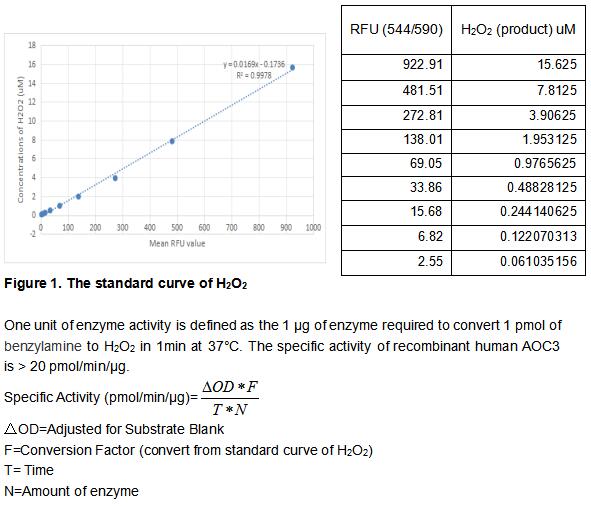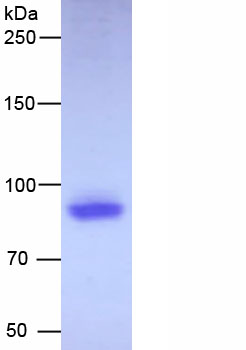Active Amine Oxidase, Copper Containing 3 (AOC3) 

VAP1; HPAO; SSAO; Membrane primary amine oxidase; Vascular Adhesion Protein 1; Semicarbazide-Sensitive Amine Oxidase; Copper-Containing Amine Oxygen Oxidoreductase
- UOM
- FOB US$ 292.00 US$ 730.00 US$ 1,460.00 US$ 4,380.00 US$ 10,950.00
- Quantity
Overview
Properties
- Product No.APC298Hu61
- Organism SpeciesHomo sapiens (Human) Same name, Different species.
- ApplicationsCell culture; Activity Assays.
Research use only - DownloadInstruction Manual
- CategoryEnzyme & KinaseInfection immunityEndocrinologyBone metabolismRheumatology
- Buffer FormulationPBS, pH7.4, containing 5% Trehalose.
- Traits Freeze-dried powder, Purity > 90%
- Isoelectric Point6.4
Sign into your account
Share a new citation as an author
Upload your experimental result
Review

Contact us
Please fill in the blank.
Activity test

Amine Oxidase, Copper Containing 3 (AOC3) is a copper amine oxidase with a topaquinone cofactor. AOC3 is a Type II integral membrane protein, but a soluble form of the enzyme is present in human serum, and its level increases in diabetes and some inflammatory liver diseases. AOC3 catalyzes the oxidative deamination of small primary amines such as methylamine, benzylamine, and aminoacetone in a reaction that produces an aldehyde, ammonia, and H2O2. The enzyme is sensitive to inhibition by semicarbazide. AOC3 expression is highest in the endothelium of lung, heart, and intestine, but low in tissues such as brain, spleen, kidney, and liver. The activity of recombinant human AOC3 was measured by its ability to produce hydrogen peroxide during the oxidation of benzylamine. The reaction was performed in 50 mM HEPES, pH 7.5 (assay buffer), initiated by addition 50 μL of various concentrations of AOC3 (diluted by assay buffer) to 50 µl substrate mixture of 2 mM Benzylamine, 2 units/mL HRP and 100 µM AUR. Read at excitation and emission wavelengths of 544 nm and 590 nm (top read), respectively in kinetic mode for 5 minutes.
Usage
Reconstitute in 10mM PBS (pH7.4) to a concentration of 0.1-1.0 mg/mL. Do not vortex.
Storage
Avoid repeated freeze/thaw cycles. Store at 2-8°C for one month. Aliquot and store at -80°C for 12 months.
Stability
The thermal stability is described by the loss rate. The loss rate was determined by accelerated thermal degradation test, that is, incubate the protein at 37°C for 48h, and no obvious degradation and precipitation were observed. The loss rate is less than 5% within the expiration date under appropriate storage condition.
Increment services
-
 BCA Protein Quantification Kit
BCA Protein Quantification Kit
-
 Molecular Mass Marker for Protein
Molecular Mass Marker for Protein
-
 Monoclonal Antibody Customized Service
Monoclonal Antibody Customized Service
-
 Polyclonal Antibody Customized Service
Polyclonal Antibody Customized Service
-
 Protein Activity Test Experiment Service
Protein Activity Test Experiment Service
-
 Electrophoretic Mobility Shift Assay (EMSA) Experiment Service
Electrophoretic Mobility Shift Assay (EMSA) Experiment Service
-
 Buffer
Buffer
-
 Lentivirus Packaging Experiment Service
Lentivirus Packaging Experiment Service
-
 Adenovirus Packaging Experiment Service
Adenovirus Packaging Experiment Service
-
 Real Time PCR Experimental Service
Real Time PCR Experimental Service
-
 Spike RBD Protein (S-RBD)
Spike RBD Protein (S-RBD)
-
 Protein G
Protein G
-
 Protein A
Protein A







